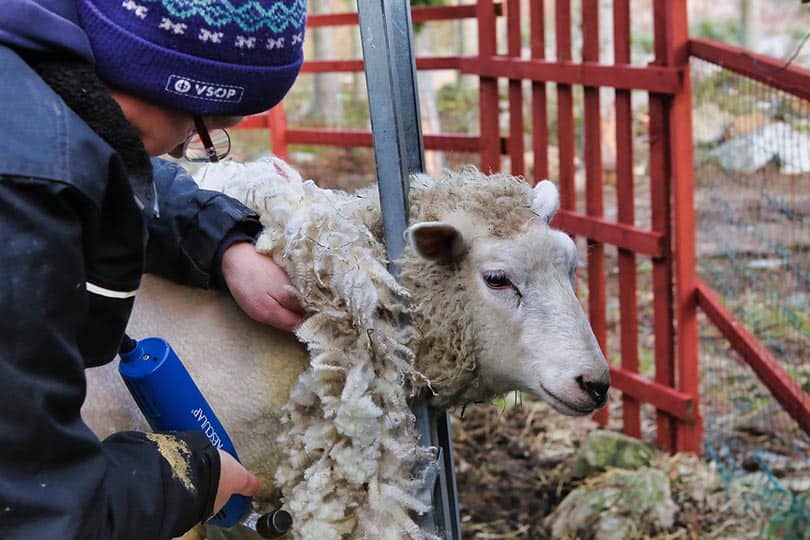Sheep have thick wool coats that continuously grow year-round. This wool is shaved or sheared off at regular intervals. The wool itself is sold for processing into bedding and clothing. Sheep didn’t always need to be sheared, but most sheep breeds have been bred so that they have lost the ability to shed naturally. They must be sheared for health reasons and to remain comfortable during seasonal changes. In modern times, sheep aren’t sheared only for financial reasons but out of pure necessity to maintain the sheep’s health. Most of them don’t enjoy the shearing process itself, but it is necessary.

Rhetoric about sheep shearing
There are many common myths regarding sheep shearing, so let’s look at a few of them here.
Sheep are sheared for financial reasons
Yes, the wool that is sheared from sheep is sold for money, but much like cattle are sold for meat, this money often goes back into feeding and caring for the sheep themselves. Without it, farmers wouldn’t be able to keep caring for their animals.

Sheep shearing is inhumane
Many animal advocate groups describe sheep shearing as akin to torture. They will show videos of sheep bleating and squirming while being held down and sheared. While this isn’t totally inaccurate, labeling it as torture is far from the truth.
Sheep, like most animals, don’t like to be held still. To make the process efficient, owners use electric clippers. If the sheep weren’t held, they would be cut by the clippers. No part of the shearing process hurts the sheep, and shearing is absolutely necessary to maintain their comfort and overall health.
Shearing a sheep is no different than taking a dog to the groomer for a trim. It is humane and safe for the sheep.
What is sheep shearing?
Sheep shearing refers to the process by which a person uses a tool to safely remove wool from a sheep. While shearing is often conducted by owners, it’s done by a trained “shearer” using either blade or machine shears designed especially for sheep shearing.
Blade shears are often used during the winter or in colder climates. They don’t shave the wool quite as close to the sheep and leave some wool behind for warmth. Machine shears are similar to beard clippers and provide a closer trim. Regardless of the tool used, sheep are cradled on their back, and the shearing process only takes a few minutes.
Shearing for a sheep feels about the same as shaving or cutting hair does to a human. It doesn’t hurt them, and they are up and back to their regular lives immediately after it’s completed. While accidents can occur, they are extremely rare, and most shearers take extra care to ensure the safety of the animals.

Why do sheep need shearing?
Domestic sheep need shearing because humans have bred out their natural shedding ability. Their wool coats grow so quickly and so thick that they actually have problems when they’re not sheared.
During the summer, the wool holds too much heat, causing sheep to overheat and be unable to regulate their temperature. If they’re not sheared, this can be fatal.
Wool also allows insects, maggots, and mites to hide and injure a sheep’s skin. The more wool a sheep has, the harder these conditions are to find and treat.
There are several health issues that can occur if sheep are not regularly sheared:
- They can’t maintain proper body weight.
- Matting and tangling cause constricted blood flow to a sheep’s limbs and painful sores, and prevents the sheep from moving naturally.
- Excessive wool can cause blindness if it grows over their eyes.
- Lambs can’t nurse from a mother who isn’t sheared, which can cause their death if not dealt with promptly.
How often do sheep need shearing?
Sheep are usually sheared once a season. Sometimes it may be necessary to shear a sheep’s wool multiple times during the summer, as their wool grows quickly and they are at risk of overheating. During the winter, they may be sheared slightly less frequently so they can stay warm.

Not all sheep need shearing
Only domestic sheep need shearing; wild breeds still shed and don’t require it. There are a few breeds of domestic sheep that don’t need to be sheared. These are breeds that don’t have continuously growing coats. They shed their wool out a few times a year.
The best comparison for this is to dogs. Dogs who are non-shedding require haircuts or trims a few times a year. Dogs who shed don’t require trims because they naturally blow out their coat. The same goes for sheep. If they shed, they can be left alone. If they don’t, they need shearing.
Cruelty during the shearing process
There are documented cases where sheep have been mistreated or harmed during the shearing process. These are cases of animal abuse, and they occur with sheep just as they occur with any other domesticated animal, including dogs, cats, horses, and other livestock.
If done properly, sheep shearing does not cause harm to sheep.

Final thoughts
Sheep shearing is a safe, humane, and necessary aspect of sheep ownership. It’s not a process to be feared; it’s nothing more than a “haircut” or “grooming” for sheep. Domestic sheep have been bred to have continuously growing wool, so they need to be sheared on a regular basis for their health and safety.
Featured Image Credit: Kitti Kulapanpaichit, Shutterstock
